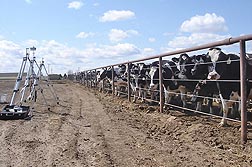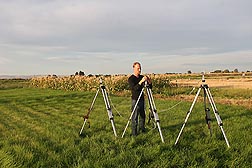Dairy Farms Are Not a Source of Far-Flung Bioaerosols
Published: December 2, 2013
By: Ann Perry, Agricultural Research Service Information Staff, USDA
 Sampling equipment (left) is set up on the downwind side of cattle pens to measure the amount of bioaerosols, such as endotoxins, bacteria, and fungi, in the air near the pens. (D3043-1) |
In the late afternoon, when fidgety dairy cows start milling around, they stir up a heavy layer of dust that hangs over the yard. This airborne dust does more than signal potential rowdiness among the livestock. It contains bacteria, viruses, fungi, and small bacterial remnants called “endotoxins,” which can be dispersed through the air beyond the facilities to the surrounding landscape.
These airborne microorganisms and their byproducts and remnants are also called “bioaerosols.” Agricultural Research Service microbiologist Rob Dungan is documenting how bioaerosol dispersal fluctuates throughout the day and year, their downwind concentrations, and factors that affect dispersal patterns.
“In the western United States, dairy cows are kept in large outdoor pens or in a combination of exercise pens and barns at open-freestall facilities. Either way, people can sometimes smell dairies before they can see them, so they assume there’s a problem,” says Dungan, who works at the Northwest Irrigation and Soils Research Laboratory in Kimberly, Idaho. “There’s a lot of interest from people in nearby communities in finding out more about their potential exposure to airborne endotoxins and other bioaerosols from these facilities.”
 ARS microbiologist Rob Dungan sets up a type of sampling equipment known as a “glass impinger,” which is used to capture airborne microorganisms, or bioaerosols. (D3047-1) |
Distance Makes All the Difference
For one study, Dungan, soil scientist April Leytem, and research leader David Bjorneberg set up three sampling sites at a 10,000-cow open-freestall dairy to measure airborne endotoxins and culturable microorganisms like bacteria and fungi during fall, spring, and summer. One site was slightly more than a tenth of a mile upwind of the facility. A second site was 165 feet downwind from a barn, and the third was 655 feet (about a tenth of a mile) downwind from the same barn.
The researchers found that overall average inhalable airborne endotoxin concentrations were 5 endotoxin units (EU) per cubic meter at the upwind site, 426 EU downwind near the barn, and 56 EU farther downwind. At the upwind and the distant downwind sites, endotoxin concentrations did not vary significantly over 24 hours. But closer to the barn, nighttime endotoxin concentrations were significantly higher than morning concentrations and were similar to afternoon concentrations—increases the scientists attribute to increased animal activity and lower wind speeds during these times.
Analysis of bacterial concentrations showed a similar pattern. Average bacterial counts over the sampling period were 2,800 colony forming units (CFU) per cubic meter of air at the upwind site; 84,000 CFU 165 feet downwind of the barn; and 7,900 CFU 655 feet from the barn. As with the daily endotoxin concentrations, bacterial concentrations near the barn increased significantly at night, but concentrations farther downwind did not.
When the scientists compared concentration fluctuations with weather conditions, they noted that endotoxin concentrations rose with air temperature. Meanwhile, airborne bacteria concentrations increased when air temperatures and wind speeds increased, but dropped when solar radiation and relative humidity increased.
No Lasting Effects
Dungan and Leytem conducted another investigation at a 10,000-cow open-lot dairy. For this study, they sampled airborne endotoxin concentrations at an upwind site about one-tenth of a mile from the lot, at a downwind site at the edge of the lot, and at the dairy perimeters, which were more than three-quarters of a mile downwind of the lot.
Average endotoxin concentrations at the downwind edge of the open lots were about 11 times higher than the concentrations upwind, while the endotoxin concentrations at the most distant downwind site were found to be statistically similar to those at the upwind site.
The scientists determined that the primary factors affecting airborne endotoxin emissions were wind speed, lot management, and animal activity. As expected, the scientists observed that endotoxin suspension and transport from the animal housing areas increased as wind speed increased and as animal activity increased. Other lot-management practices, including breaking up the manure with harrowing, also generated higher airborne endotoxin concentrations.
Unlike airborne microbes like bacteria and fungi, endotoxins are highly resistant to solar radiation and temperature. The researchers did not observe any significant correlations between fluctuations in endotoxin levels and changes in air temperature, solar radiation, or relative humidity.
“As with other types of livestock facilities, dairies are a source of bioaerosols because they house many animals that generate lots of manure,” says Dungan. “But our data shows that bioaerosol concentrations reach normal background levels at a fairly short distance from their source at the dairies. So people who live near these facilities can hopefully breathe a sigh of relief about potential bioaerosol exposures.”—By Ann Perry, Agricultural Research Service Information Staff.
This research is part of Agricultural and Industrial Byproducts (#214) and Climate Change, Soils, and Emissions (#212), two ARS national programs described at www.nps.ars.usda.gov.
Robert Dungan, April Leytem, and David Bjorneberg are with the USDA-ARS Northwest Irrigation and Soils Research Laboratory, 3793 North 3600 East, Kimberly, ID 83341; (208) 423-5582.
"Dairy Farms Are Not a Source of Far-Flung Bioaerosols" was published in the November/December 2013 issue ofAgricultural Research magazine.
Source
Ann Perry, Agricultural Research Service Information Staff, USDARelated topics:
Recommend
Comment
Share

Would you like to discuss another topic? Create a new post to engage with experts in the community.





